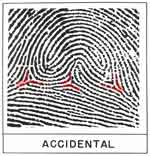The History of Fingerprinting:
 Fingerprint identification is a revolutionary method that has assisted law enforcement officials and investigators in capturing criminals. Fingerprinting has been used even in prehistoric times; such as in the ancient cities of Babylon and china, (around 1,000-2,000 B.C.) in which fingerprints were pressed on clay slabs for business transactions.
Fingerprint identification is a revolutionary method that has assisted law enforcement officials and investigators in capturing criminals. Fingerprinting has been used even in prehistoric times; such as in the ancient cities of Babylon and china, (around 1,000-2,000 B.C.) in which fingerprints were pressed on clay slabs for business transactions. However, fingerprinting was used to solve crimes around 1892 in which an Argentinian police officer arrested a woman named Rojas who murdered her two sons. In 1883 Mark Twain spawned the idea of using fingerprints for identification in his book Life on the Mississippi in which a murderer was caught using fingerprint identification.
However, fingerprinting was used to solve crimes around 1892 in which an Argentinian police officer arrested a woman named Rojas who murdered her two sons. In 1883 Mark Twain spawned the idea of using fingerprints for identification in his book Life on the Mississippi in which a murderer was caught using fingerprint identification.This however, was just the beginning of fingeprint identification. for example, in 1977, the FBI (Federal Bureau of investigation) invented the "Automated Fingerprint Identification System" with the first computerized scans of fingerprints. It has been determined that the chances of finding someone with the same fingerprint is 1 in 64 billion.
Types of Fingerprints:
A direct fingerprint is a type in which the fingerprint is unaltered or undisturbed. They are pressed down with ink on clear and flat surfaces. These are commonly used for government records or security.
Latent Fingerprints:
 A latent fingerprint is a type in which the fingerprint may be smudged, disturbed, etc. Latent fingerprints are usually smeared and undetectable. They have unclear ridge structures and are sometimes overlapped.
A latent fingerprint is a type in which the fingerprint may be smudged, disturbed, etc. Latent fingerprints are usually smeared and undetectable. They have unclear ridge structures and are sometimes overlapped.Plastic Fingerprints:
A plastic fingerprint is a type in which the original shapes of the fingerprint’s ridges are preserved such as an impression on clay
Non-Absorbent surfaces:
 super glue method: Obtain the object with the fingerprint, aluminum foil, super glue, and a jar. (note: the fingerprint will not be visible to the naked eye at first) Next, insert aluminum foil along the bottom of the jar, and place the object with the fingerprint in the jar as well. Next, add a few drops of super glue to the aluminum foil and close the lid. After a few minutes, the print wil become visible
super glue method: Obtain the object with the fingerprint, aluminum foil, super glue, and a jar. (note: the fingerprint will not be visible to the naked eye at first) Next, insert aluminum foil along the bottom of the jar, and place the object with the fingerprint in the jar as well. Next, add a few drops of super glue to the aluminum foil and close the lid. After a few minutes, the print wil become visibledusting and Lifting method:
Before a forensic scientist can begin, he must determine whether to use Talc or a black powder, his decision will depend on the color of the surface in which the fingerprint was on. Then, the poweder must be carefully applied over the fingerprint with the brush. finally, the fingerprint will be picked up by placing adhesive tape over the print and carefully peeling it back.
Porous and soft surfaces:
Fuming for Iodine:
One of the oldest methods used is the iodine method which is utilizes a chemical to cause the fingerprint to appear. The chemical iodine, in its solid phase, is added into a container with the item with the fingerprint. The iodine is heated and turned into a gas without passing the liquid phase. The vapor will combine with the parts of the print; thus making the print visible. However, the print will disappear after the vapor stops.
Basic Fingerprint patterns:
The basis of all known fingerprints originates with these:
Plain whorl:
These fingerprints appear similar to ripples in a pond. they are characterized by the rings around the center.
Central Pocket Whorl:
These fingerprints are similar to plain worls, however the rings around the center connect at onepoint
Double Loop Whorl
These fingerprints have a distinct "S" shape. They have two sets of loops in different directions
Accidental Whorl:
These distinct fingerprints have three common interesctions onm the bottom and form an arch.
These fingerprints are not very common.
Radial loops depend on what hand they're on. this one originates from the left to the center.
Ulnar Loops:
These fingerprints are similar to Radial loops. They also depend on which hand the print is on. They originate from the bottom right to the center
These fingerprints are have a very slight arch on the top and the bottom lines remain straight.
Tented Arch:
These Fingerprints are similar to plain arches, but they have a large pointed arch originating from the bottom.











7 comments:
I think this looks great! I think all of your images are arranged very nicely and I love how bright and colorful it is!
wow Isai, fantastic amount of information. I feel like this is a class.
the pictures make it easy for us to understand as well :D
yeah this is fantastic!
I never imagined that fingerprints were used in business such a long time ago.!
The many types of patterns are fascinating!
You did great.
ね、 朝美ちゃん。 異才のブログは素晴らしいね?
いさいがすごいな学生だから!
yeah! he is a good student ^-^
the details and everything was excellent. It seems like an interesting topic to learn about!
Wow, good job! I never thought about what would happen if the fingerprints overlapped. I liked your pictures and I can really tell that you put a lot of hard work into this blog.
This page looks amazing! The only thing I see that confuses me is the citations being under each individual section. I think it's great that people looking at your blog can see your sources right away but I think it looks a little unorganized. If you have a lot of sources, you could put them on their own page and label them but really great info. :)
the whole thing looks amazing, i should have done what you did. amazing work.
Post a Comment